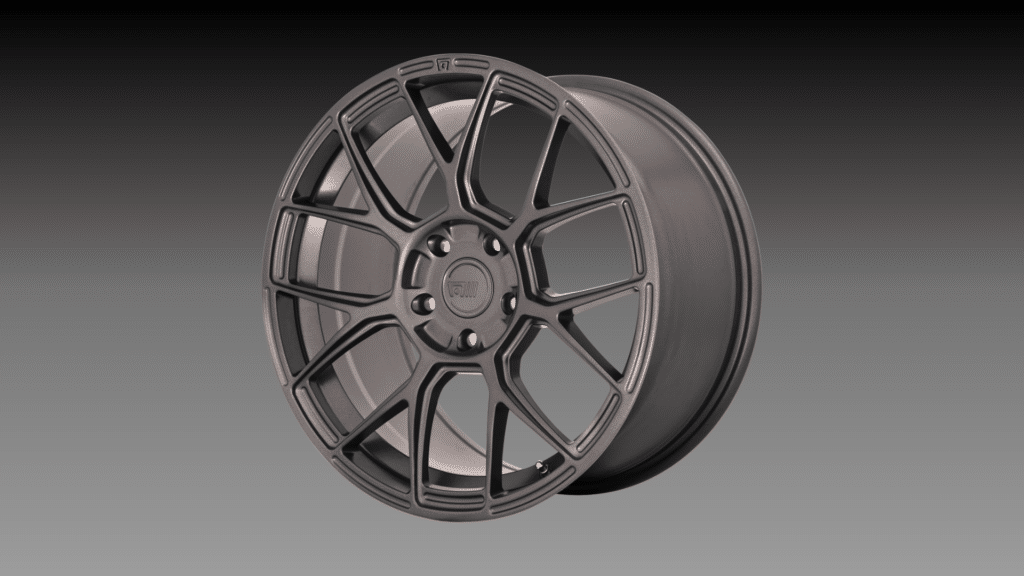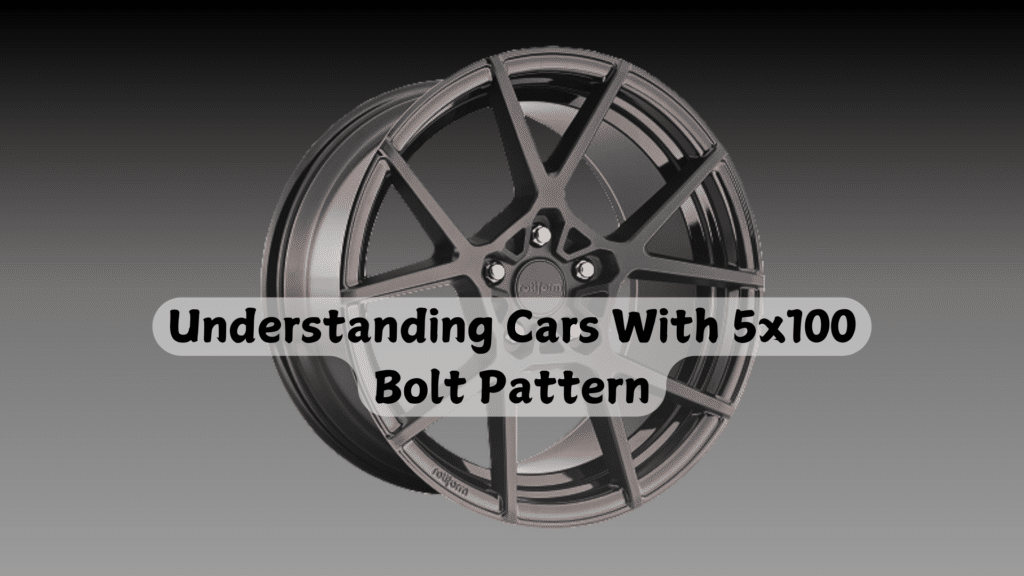Are you tired of looking at wheel options, and are you unsure if they’ll fit your car?
You’re not alone.
Many car owners struggle to understand wheel fitment, especially the 5×100 bolt pattern common in many vehicles.
In this guide, we’ll explain everything about the 5×100 bolt pattern—from which cars use it to how to measure it correctly.
Whether you’re a home mechanic or simply want to upgrade your wheels, you’ll learn what you need to know.
By the end of this article, you’ll understand:
- How to check if your car has a 5×100 bolt pattern
- Which popular car models use this pattern
- Common mistakes to avoid when selecting wheels
Understanding Cars with 5×100 Bolt Pattern & Its Measurements

The numbers in “5×100” tell an important story about your wheels.
The “5” shows how many lug nuts hold your wheel to the car.
The “100” indicates the circle size—it is 100 millimeters across when measured through the center of the bolt holes.
Think of it like a circle with five equally spaced points.
When you measure from the middle of one bolt hole, straight through the center, to the opposite bolt hole, you’ll get 100 millimeters.
Here’s how to check your bolt pattern:
- Get a measuring tape or ruler (in millimeters)
- Find two opposite bolt holes
- Measure from the center of one hole to the center of the other
- If it’s close to 100mm, you likely have a 5×100 pattern
For better accuracy, you can buy a bolt pattern tool from any auto parts store.
These tools make measuring quick and exact.
Why do so many cars use 5×100?
This size became popular in the 1990s when companies like Subaru and Volkswagen needed a strong but light setup for their smaller cars.
Five lugs give enough strength for most passenger cars while keeping the wheel hub small and light.
Many car makers still use this pattern today because:
- It works well for most passenger cars
- It keeps manufacturing costs down
- It’s proven reliable over time
What Should Be Considered When Choosing Wheels for a 5×100 Bolt Pattern?
Let’s start with wheel offset – it’s the distance between your wheel’s mounting surface and its centerline.
The right offset keeps your wheels sitting perfectly under your fenders.
Too much or too little offset can cause problems with:
- How your car handles
- Tire rubbing against fenders
- Proper brake clearance
The center bore—the big hole in the middle of your wheel—matters more than you might think.
It must be the same size as or larger than your car’s hub.
If it’s larger, you’ll need hub-centric rings to make it fit.
Weight matters when picking wheels.
Each wheel needs to handle its share of your car’s weight, plus extra force from bumps and turns.
Look for these details:
- The wheel’s weight rating
- Your car’s total weight
- The size that fits your needs
- Width that works with your tires
Pick wheels that match your style.
You’ll look at these wheels every day, so choose the ones you’ll enjoy seeing.
Think about:
- What finish you want (black, silver, bronze)
- How many spokes look best
- Which brands fit your budget
- What style suits your car
Remember: A wheel that fits right will work better and last longer than one chosen just for looks.
How Do You Install Wheels on Cars That Use a 5×100 Bolt Pattern?
I’ll help you put on new wheels safely and correctly.
Let me show you the necessary tools and walk you through each step.
Tools You’ll Need
- Torque wrench
- Car jack
- Jack stands (2 or more)
- Socket set
- Safety glasses
- Work gloves
- Wheel blocks
- Clean rags
Step 1: Getting Your Car Ready
Start by parking your car on a flat, solid surface.
Then, put your car in park (or first gear for manual cars) and pull the parking brake.
Finally, put wheel blocks behind the wheels so they will stay on the ground.
Step 2: Safety First
I always tell you to lift your car with the jack but never work under a car that’s only held up by a jack.
Once you lift the car, put jack stands under the proper lifting points.
Your car’s manual will show you where these points are.
Step 3: Taking Off the Old Wheels
Loosen the lug nuts while the wheel is still on the ground—this gives you better leverage.
Once they’re loose, lift the car and remove the nuts completely.
Then, remove the old wheel.
Step 4: Checking and Cleaning
Clean the hub surface where the wheel sits.
Look for rust or damage.
A clean surface helps the wheel sit properly and prevents wobbling.
Step 5: Putting On the New Wheels
Line up the wheel holes with the 5×100 bolt pattern.
Put the wheel on and hand-tighten the lug nuts.
Don’t fully tighten them yet.
Step 6: The Right Way to Tighten
Lower the car until the wheel touches the ground but still has some weight on the jack.
Now tighten the lug nuts in a star pattern – going from one nut to another across the wheel, not in a circle.
Use your torque wrench set to the right specs from your car’s manual.
Step 7: Final Check
Lower the car completely and check all lug nuts for tightness.
Drive for about 50 miles, then check again—this is important because new wheels often need a slight adjustment after their first use.
Remember: Wrong installation can be dangerous.
If you’re not sure about any step, it’s better to ask a professional for help.
Common Mistakes to Avoid During Installation
1. Choosing the Right Hardware
Getting your lug nuts right is key.
The thread size must match your wheel studs perfectly.
Double-check both the thread pitch and length – these small details make a big difference.
Using the wrong size can strip your threads or leave your wheel loose.
Ensure the seat type matches your wheels, too – you can’t mix flat-seat lugs with conical-seat wheels.
2. Getting the Tightness Right
Finding the perfect tightness matters more than you might think.
Over-tightening can break wheel studs, warp your rotors, or crack your wheels.
Going too loose is just as bad – your wheels could wobble or even come off.
Always use a torque wrench set that fits your car’s exact specs.
Don’t trust your arm strength to get it right.
3. Understanding Hub-Centric Rings
Those small rings make a huge difference.
If your wheels need hub-centric rings, don’t skip them.
These rings keep your wheel perfectly centered on the hub.
Without them, you’ll feel shaking at highway speeds, your tires will wear unevenly, and your wheel bearings might fail early.
Think of them as the centering guides for your wheels.
4. Testing After Installation
Take time for a proper test drive.
Even a short drive around your neighborhood can tell you if something’s wrong.
Listen for new sounds, feel for steering wheel movement, and pay attention to your brake feel.
After the test drive, check each wheel hub for unusual heat and make sure your lug nuts are still tight.
Pro tip: Write down your installation date and when you need to check the torque again.
Most wheel manufacturers suggest checking after 50 miles of driving.
Applications of the 5×100 Bolt Pattern in Different Vehicles
| Car Type | Common Models | Why They Use 5×100 | Benefits |
|---|---|---|---|
| Sports Cars | Subaru WRX (2002-2014) Toyota 86 Subaru BRZ | – Strong enough for fast driving – Light weight helps speed – Good brake clearance | – Better handling – Less weight on suspension – Works well with big brakes |
| Family Cars | Volkswagen Golf (1999-2014), Toyota Corolla (2003-2013), Subaru Impreza | – Perfect for daily use – Easy to find parts – Fits most wheel types | – Simple maintenance – Many wheel options – Lower repair costs |
| Small SUVs | Subaru Forester (1998-2013) Toyota RAV4 (2001-2005) | – Strong enough for heavier cars – Good for light off-road use – Handles extra weight well | – Fits many tire sizes – Good for all seasons – Stands up to rough roads |
| Custom Cars | Most modified imports Track day cars Show cars | – Wide wheel selection – Many sizes available – Easy to find used parts | – Simple to upgrade – Mix and match wheels – Good for special builds |
Note: Years shown are when these models typically used a 5×100 pattern.
Check your specific car’s manual to be sure.
Benefits of the 5×100 Bolt Pattern
I want to explain why the 5×100 bolt pattern is a practical choice for many cars.
This common pattern offers real benefits that make sense for daily driving.
1. Wide Wheel Selection
You’ll find plenty of wheels that fit this pattern.
More choices mean better chances of finding wheels that match both your style and budget.
Many car makers use this pattern, which helps keep prices fair due to high production numbers.
2. Easy Replacement
When you need new wheels, you won’t have trouble finding them.
Local shops often keep these wheels in stock.
You can also order them online without waiting for special orders or paying extra fees.
3. Proven Safety Track Record
The 5×100 pattern has been tested over many years.
Car makers picked this design because it spreads the weight evenly across five points.
This even spread means less stress on each bolt, which helps keep your wheels secure.
4. Fits Many Car Models
Here’s something useful: If you own different cars with the same bolt pattern, you can swap wheels between them.
This works great for:
- Winter tire setups
- Track day wheels
- Spare wheel sharing
- Wheel upgrades
5. Simple Maintenance
You’ll find that working with five bolts hits the sweet spot. It’s:
- Enough bolts to hold securely
- Not too many to make changes time-consuming
- Easy to remember the star pattern for tightening
Remember: The 5×100 pattern may look simple, but its design comes from years of testing and real-world use.
That’s why so many car makers still use it today.
List of Vehicles Using 5×100 Bolt Pattern
| Brand | Model | Years | Key Notes |
|---|---|---|---|
| Subaru | WRX | 2002-2014 |
– Good for upgrades – Strong build – Popular in tuning |
| Impreza | 1993-2014 |
– Long-lasting – Easy to find parts – Works with many wheels |
|
| Legacy | 1990-1999 |
– Solid base car – Takes standard sizes – Good daily driver |
|
| Volkswagen | Golf | 1999-2014 |
– Common in shops – Simple to maintain – Lots of wheel options |
| Jetta | 1999-2014 |
– Same as Golf parts – Many wheel styles fit – Easy replacements |
|
| Beetle | 1999-2010 |
– Fun to customize – Standard sizes work – Parts easy to find |
|
| Toyota | Celica | 2000-2005 |
– Sport styling options – Light wheels work well – Good part support |
| Matrix | 2003-2008 |
– Practical sizing – Many wheel choices – Simple upgrades |
|
| Corolla | 2003-2013 |
– Common wheels fit – Basic maintenance – Budget-friendly |
|
| Scion | tC | 2005-2010 |
– Good for mods – Sport wheel options – Easy to find parts |
| xB | 2004-2006 |
– Simple to work on – Many wheel styles – Parts widely available |
Conclusion
Now you know why the 5×100 bolt pattern matters for your car.
You’ve learned what makes these wheels work and how to put them on safely.
Let’s recap what’s most important:
Key things to remember:
- Always check your measurements twice
- Get your torque settings right
- Do those safety checks
If you’re working on your wheels at home, take your time and follow each step carefully.
The good news is that with 5×100, you’ve got plenty of wheel options to choose from.
Do you still have questions?
Talk to your local wheel shop or check your car’s manual.
The right wheels can make a big difference in how your car looks and drives.
Stay safe, and enjoy your ride!
Frequently Asked Questions
Can I Use Wheel Spacers With My 5×100 Wheels?
Yes, but only use quality spacers with proper thickness for your car.
Get hub-centric spacers and longer lug bolts.
Never exceed 25mm spacer thickness.
How Often Should I Rotate My 5×100 Wheels?
Rotate your wheels every 5,000 to 7,000 miles.
This helps tires wear evenly and extends their life.
Mark your calendar or note your mileage.
What’s The Most Common Problem With 5×100 Wheel Installation?
The biggest issue is cross-threading lug nuts.
Start each nut by hand, then use the wrench.
Never force them if they feel tight.


